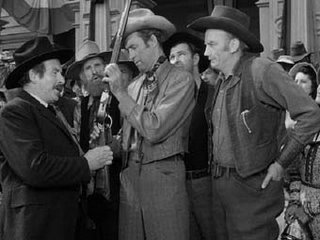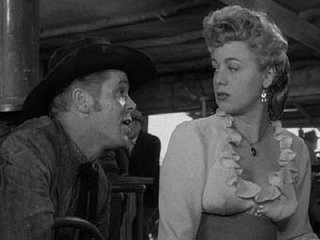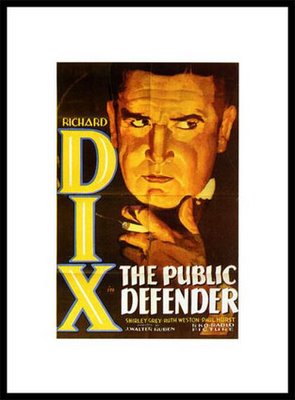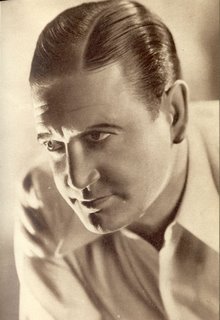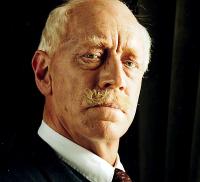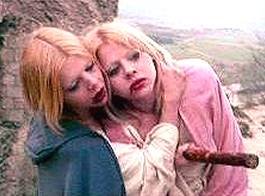 The Hound of the Baskervilles (1959)
The Hound of the Baskervilles (1959)Director: Terence Fisher
By Roderick Heath
This is the best film of Sir Arthur Conan Doyle’s book. In fact, it’s better than the book. Doyle’s Sherlock Holmes novels hardly stack up against his short-story gems. The novel of Hound shoots itself in the foot by blowing the cover on its villain halfway through, then stumbling through an anti-climactic last act. It also avoids examining undercurrents the story presents, even copping out of the science/superstition clash that drives the narrative, only flirting with the ideas comically when Bishop Frankland threatens to sue amateur anthropologist Dr. Mortimer for body-snatching in his digs at Neolithic sites. But Doyle fails to bring anything to a point. He even writes Holmes out of half of the novel.
Armed with a tight screenplay by John Bryant, Fisher’s film charges with force into the story’s potential. Opening with a typically thunderous James Bernard score timed with lightning bursts, the camera closes in slowly on the matte-painted Baskerville Hall. The velvet-threat tones of Francis de Wolff, playing Mortimer, intones the legend of the hound. In the 17th century, a tenant farmer is tortured in the Hall by aristocratic cads because he stood between his daughter—imprisoned upstairs—and Sir Hugo Baskerville (played with perfect sleazy elegance by David Oxley). Baskerville, for a coup de grace, roasts the man in the fireplace.
Sir Hugo has to pay up on a wager to his fellow noble scoundrels on how long the man would last, and being the gentleman he is, he proposes paying with the girl. Proceeding upstairs, he finds the girl has absconded out the window via the ivy-covered walls. Hugo orders his hunting hounds released to chase her down, and sets out on horseback, crying “May the hounds of hell take me if I can’t hunt her down!” He catches her in the fog among wreathed ruins of an abbey and stabs her death with relish. He is then confronted by a growling, unseen monster that devours him greedily amid the creep’s blood-curdling screams.
Having gotten our attention, Fisher dissolves to Holmes’ study as Mortimer concludes his reading. Unlike the novel’s agreeable geek, this Mortimer is a fat, faintly shifty self-publicist who responds huffily to Holmes’ less-than-enthralled air. Peter Cushing’s Holmes is introduced, his pencil-thin form leisurely lifting his hand with a gasp of vision not at Mortimer’s words but to play a chess move that’s occurred to him. Watson is played by Andre Morell, who had portrayed Nigel Kneale’s scientific titan Quatermass on television, making it clear he’s not a Nigel Bruce buffoon but a quick-witted, if slightly old-boyish, colleague.
 Dr. Mortimer engages Holmes to solve the mysterious death of Sir Charles Baskerville with a litany of relishable clues, such as the footprints of a gigantic hound and the fact that Sir Charles tiptoed (“But he wasn’t tiptoeing,” Cushing intones, “He was running, Watson, running for his life until he burst his heart!”). Holmes is also to protect Sir Charles’ heir, Sir Henry (Christopher Lee), who, it soon turns out, needs protection badly. There’s a stowaway tarantula in his boot, that crawls onto his shoulder (suggesting, in one shot, a large lump of lint), and is disposed of by Holmes who hits it like he’s killing an anaconda. Though hardly dangerous to anyone else, the spider could have been fatal to Sir Henry, with hiss inherited heart condition. Holmes announces he must stay in town, so he has Watson accompany Mortimer and Sir Henry to Baskerville Hall.
Dr. Mortimer engages Holmes to solve the mysterious death of Sir Charles Baskerville with a litany of relishable clues, such as the footprints of a gigantic hound and the fact that Sir Charles tiptoed (“But he wasn’t tiptoeing,” Cushing intones, “He was running, Watson, running for his life until he burst his heart!”). Holmes is also to protect Sir Charles’ heir, Sir Henry (Christopher Lee), who, it soon turns out, needs protection badly. There’s a stowaway tarantula in his boot, that crawls onto his shoulder (suggesting, in one shot, a large lump of lint), and is disposed of by Holmes who hits it like he’s killing an anaconda. Though hardly dangerous to anyone else, the spider could have been fatal to Sir Henry, with hiss inherited heart condition. Holmes announces he must stay in town, so he has Watson accompany Mortimer and Sir Henry to Baskerville Hall.First seen in delicately menacing sunlight with Bernard’s eerie oboe scoring, Dartmoor soon becomes a nightmare-drenched wonderland. There’s the convicted killer of prostitutes Selden (David Birks) loose from Dartmoor Prison, for piquance. There’s dingbat local minister and entomologist Bishop Frankland (Miles Malleson), for comic relief. Or is he? Did the tarantula come from his collection? Why does Mrs. Barrymore (Helen Goss), wife of the trusty housekeeper (John LeMesurier), weep at night? Why is Selden signaling to the hall? What are saturnine farmer Stapleton (Ewen Solon) and his enfant sauvage daughter Cecile (Marla Landi) up to?
Despite the noisy music and equally loud color, Fisher’s films are marked by a cool mixture of poetic realism and tightly built sequences, and, as in The Hound of the Baskervilles, a riot of florid atmosphere--rotting leaves, jagged stone, dawn-lit moors, rustling silk, blood-red coats, Marla Landi’s earthy skin, dripping mines, lanterns, and black bogs. Fisher’s Hammer films revitalised British cinema and rode point for a revolution of Horror popularity that only ran out of steam some 25 years later. Fisher began his directorial career in stultifying quota quickies. His one early work of note was So Long At The Fair (1951), featuring Dirk Bogarde and Jean Simmons, a fascinating mystery based on a great urban myth. The film sits heavily under the starchy influence of the standard period film, and would have benefited from Fisher’s later, rowdier touch.
Indeed, before the Fisher-Hammer explosion, British genre cinema, though rich and fascinating, lacked the damn-the-torpedoes drive of their American brethren. Suddenly, that WWII-era, stiff-upper-lip veneer cracked, and out came a bloody-gorged beauty, luxuriating in sex, violence, pounding melodrama, black humor, and with a coherent thematic agenda. Like the “Angry Young Man” tales that were emerging at the same time, Fisher’s early Hammer films jumped with the eagerness of a terrier on rats onto the skeletons in the English cupboard--particularly sex, class, and religion. Hollywood and European Horror of the ’20s and ’30s, only took cues from Freud and surrealism. This hitherto unexplored element in the Gothic genre became, in the hands of ’60s Horror practitioners, at its best a potent vessel for revisionist views of history, power relations, and morality shifts.
Dracula, for instance, the invading foreign seducer preying on the flower of English femininity, was refashioned by Fisher and Lee as a suave precursor of James Bond, a vampire Heathcliff, a variant on the handsome ruffians Stewart Granger played years before. Amidst the generic explosion the success of the early Hammer productions generated, Fisher’s films laid down the blueprint for a movement away from purely metaphoric horror into more socially and psychologically aware works. Whilst too many horror stories are reflexively conservative creations, serving up doses of misogyny, fear of sexual deviancy, and needful conformity, Fisher began a trend that would be expanded on by later directors such as Peter Sasdy, Michael Reeves, Gordon Hessler, Hans Geissendoerfer (in his vampirism-is-Hitlerism parable Jonathan [1968]), Roman Polanski, and George Romero. Robin Hardy’s The Wicker Man, written by Anthony Shaffer and starring Lee, created as a parody/tribute, inverted Fisher’s style by replacing Gothic chic with deceptive folkish whimsy, but reverently employed his intellectual approach. Much later, Fisher would be paid homage by Neil Jordan with his remarkably bizarre fantasy The Company of Wolves (1984) and Tim Burton’s Sleepy Hollow (1999).
Fisher’s films show a consistent fascination with the relationship of Manichaeistic forces: good and evil and their fraught relationship. As axiomatic as this fascination sounds in the genre context, it is, in fact, hardly so. Some directors, Jean Rollin for instance, regarded traditional “good” as an idiotic blind alley. Others, from Murnau through to Polanski and Romero, regard it as fragile and ineffective. Still others, the true exploitation directors, conform to standard moralist structures even as they rejoice and celebrate what they purport to condemn. In Fisher’s films, good and evil stand entwined, evil usually rather more attractive than good, and fatally so.
Fisher’s moral eye was unpredictable, original, and inescapable. He turned tragic titan Victor Frankenstein into a ruthless, destructive sociopath, a meddler so driven to discover that everything, even human life, becomes incidental. He is light years from Colin Clive’s preening motherly male, instead a manifestation of the alienation found in Edward Teller’s disinterested statement about the detonation of the atomic bomb he helped create: “Who wants to see that? It’s just a big bang.” Fisher then became the only director to do anything interesting with Dracula’s nemesis, Van Helsing, turning him from aged savant into dashing man of iron, comforting in his fearless resolve and paternal, caring strength, but frightening in his puritanical brutality and willingness to crush the leech-like sensuality of vampires (usually women). As well as the first servings of truly in-your-face gore in his stakings, Fisher also offered a clear statement of the painful relation between “good” and “repression,” an indictment of for-your-own-good regimes.
In The Hound of the Baskervilles, Holmes stands in the same position as Van Helsing and Dr. Frankenstein as an arbiter of rationalism in an ignorant, intellectually sluggish world; he is Frankenstein with a moral compass. He clears away the shadows and reveals the greasepaint and old rope used by Stapleton to make Sir Henry think the past is quite literally haunting him. Holmes is (here at least) a less interesting figure than Cushing’s Frankenstein and Van Helsing, except in his haughty, egotistical streak, a strong trait in the stories, more emphasized here than any other film.
 The film is most crucially interesting in remoulding the relationship of Sir Henry and Stapleton’s daughter (in the novel, his actual wife, forced to pose as his offspring to make his potential future claims easier). Casting Lee as the descendent of the depraved Sir Hugo marks him as a powerful, imperious, sexually magnetic presence. As such, far more meaningful than the novel’s pallid baronet, Sir Henry is attracted to the gleaming-eyed, sullen-mouthed, Spanish-born Cecile Stapleton (Marla Landi), who provokes and yet runs from his stirred lust. Sir Henry is cursed with the same rapacious instincts as his ancestor, but so is Cecile--her fire is the Baskerville genes sharpened by deprivation and centuries of rage held by the peasantry towards their aristocratic exploiters, to their deadliest, most sexually sadistic point. A femme fatale to the max, Cecile is Sir Hugo returned in his victim’s body.
The film is most crucially interesting in remoulding the relationship of Sir Henry and Stapleton’s daughter (in the novel, his actual wife, forced to pose as his offspring to make his potential future claims easier). Casting Lee as the descendent of the depraved Sir Hugo marks him as a powerful, imperious, sexually magnetic presence. As such, far more meaningful than the novel’s pallid baronet, Sir Henry is attracted to the gleaming-eyed, sullen-mouthed, Spanish-born Cecile Stapleton (Marla Landi), who provokes and yet runs from his stirred lust. Sir Henry is cursed with the same rapacious instincts as his ancestor, but so is Cecile--her fire is the Baskerville genes sharpened by deprivation and centuries of rage held by the peasantry towards their aristocratic exploiters, to their deadliest, most sexually sadistic point. A femme fatale to the max, Cecile is Sir Hugo returned in his victim’s body.Likewise, Stapleton (Ewen Solon)--in the novel an insidious, devious naturalist, a false-benign opposite of Holmes--here plays the gentleman farmer but crippled (by an inherited trait of Sir Hugo’s, a plot point) and down-at-heel, generating his evil plot with native cunning rather than intellectual prowess. The Stapletons’ revenge enacts the classic “return of the repressed.” In the film’s breathlessly well-staged finale (apart from a less-than-terrifying mutt), Cecile, having lured Sir Henry to the Abbey, the ruins of which are, throughout the film, a bullring-like battleground of good and evil, and turns their passionate tryst to a mocking tirade in preparation to serve Sir Henry up for dinner. Doyle had a singular running theme of abused women in his stories--in one, a maltreated wife fills her villainous husband with the entire magazine of a revolver, to Holmes’ and Watson’s unblinking approval--and characterized Miss Stapleton as a terrified dove trapped by her husband. Fittingly, where in the book it is Stapleton who is sucked into Grimpen Mire, here Cecile is last seen sliding into the muck. The evil of the Baskervilles, their greedy sexuality, dies with her.
Fisher, though not as decoratively sophisticated as Bava, was great at pace and action--two elements that directors with infinitely larger budgets and resources can never get in proper balance. None of his films slow for a second, whilst remaining as coherent as filmmaking can get. His trademark touches include vigorous close-ups and deep-focus dioramic shots that bind together elements and crystallise the action. Fisher expanded his intensely rhythmic approach to editing (his first job in pictures), and The Hound of the Baskervilles stomps on its tackier production elements to create a film of racing verve.
Hound was a comparative box office failure, because the audience resented a lack of monsters, so a planned series of Holmes films did not join the painfully distended Frankenstein and Dracula cycles. Fisher continued provided visitations on traditional themes, though his romantic variation on The Phantom of the Opera (1962) proved a big flop and stalled his career. Generally out of place as Hammer films became sillier, sexier, and more violent, Fisher served up one more bona fide classic and the last word on his Manichaeistic themes, The Devil Rides Out (1967), from a Dennis Wheatley novel. He turned in a couple of more half-hearted Frankenstein flicks and the limp The Lost Continent (1968) before retiring and dying in 1980. l
A small note of trivia: Michael Hawkins, who plays the most prominent of Sir Hugo’s cronies, is the father of Christian Slater.
 Excellent Cadavers (2005)
Excellent Cadavers (2005)
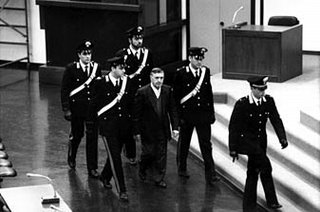

 Winchester '73 (1950)
Winchester '73 (1950)